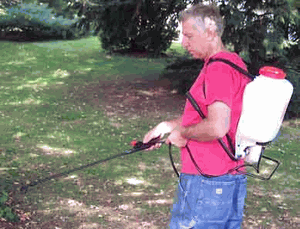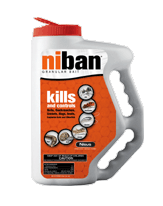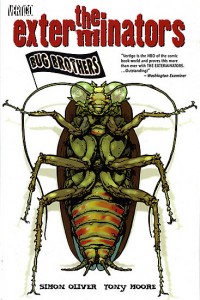We have discussed quite a number of things and I hope it’s given you some insight on how insects enter our homes. I realize this isn’t a complete work on the subject and there may be other ways to exclude pests but if we tackle just these few and minimize them as entry points we can all live as bug free as possible.
The final aspect of pest proofing is the one almost everyone turns to right away. The first time you see a roach, it’s quick to the cabinet and out with the raid. Blast him and all is good. A mouse scurries across the floor and the D-Con box gets put into place in between 15 snap traps drooling with peanut butter. While quick action is sometimes needed it is often unnecessary if you take the time to ‘proof’ the home before this occurs. Once all the other steps have been taken a good exterior treatment may reduce inside spraying to a bare minimum.
Chemical barriers can be quite effective in sealing up the home in that they kill, reroute or repel the pests on the outside before they come in. Well placed treatments can make up for areas they can’t be sealed completely such as garage doors, under decks or tiny unseen cracks. Treatments can also extend out further than the house to the source itself like a fire ant mound in the yard or a Box elder tree that would be too costly to cut down. The flexibility of a chemical barrier is only limited by your knowledge and of course the label on the product you are using. Take time to be familiar with both and your barrier will be very efficient.
There are many products you can use and I’ll suggest a few as we go along, for now let’s use for categories to work from and see how each compliments the other.
Liquid residual sprays
 One of the easiest barriers to place and quite versatile liquid barriers are a mainstay of your exterior treatment. Care should be taken to wear the proper PPE (personal protective equipment) when spraying however and I can’t stress this enough. You’ll wish you had a mask and eyewear the first time the wind kicks some back in your face believe me. Hand pump sprayers can work for you but a back pack sprayer will be far superior. It usually can shoot the higher parts such as peaks of eaves a lot easier and you won’t wear out your arm pumping it up every few feet. Set the sprayer on the finest pin stream you can get and you are ready to go.
One of the easiest barriers to place and quite versatile liquid barriers are a mainstay of your exterior treatment. Care should be taken to wear the proper PPE (personal protective equipment) when spraying however and I can’t stress this enough. You’ll wish you had a mask and eyewear the first time the wind kicks some back in your face believe me. Hand pump sprayers can work for you but a back pack sprayer will be far superior. It usually can shoot the higher parts such as peaks of eaves a lot easier and you won’t wear out your arm pumping it up every few feet. Set the sprayer on the finest pin stream you can get and you are ready to go.
I like to think of myself as an artist when using any sprayer. Quirky? Yes but I hate being sloppy and it helps me to be more thorough and that’s what you want to be. Start at the garage (there’s a reason for that) and treat around frame work, the eave line above and the expansion joint in the cement where the drive meets the garage floor. I almost always treat inside the garage on exterior treatments and any screen porches or attached sheds for that matter so move in and spray the garage before continuing.
Now start around the home moving from left to right. Spray the eaves along the top of the walls. Be in front of the spray as best you can so any drift falls away from you. Treat around any window frames, doors, water spickets, cable portals, shutters etc. You can spray the base of the home using the pin stream but it’s not going to be real effective. I recommend you place the sprayer on fan or cone spray when done and walk back around the opposite way and do the 1 and 1 rule. One foot up on the house and one foot out. Going the opposite direction may allow you to see things at another angle that you possibly have missed. When you get back to the garage (if you have one) retreat the door frame areas one more time. This by far is the largest opening any home will have and so a second go round may serve you well.
Granule Barrier
This is a simple process and it gives you a nice fresh barrier every time it rains or the sprinkler comes on. Most granule insect ides come in ready containers so you simply walk and shake. The granules work best in the soil areas around your house and I hardly ever put granules on cement. It’s too easy for a dog or child to come in contact with them and they get displaced to unwanted areas when you mow, sweep or use a leaf blower. A 2 to 3 foot wide placement is fine and this process is done.
Granular Baiting
Much the same as granular insecticides they are available in shaker containers. Place the bait also in a 2 to 3 foot swath all around the home on the soil or grassy areas. I wouldn’t be too concerned  about the baits being contaminated by the granules or even by the 1 foot spray barrier. Some might be but very little, they’ll be enough that lands in optimum places where hungry bugs can find it and take their last meal. I always shake a bit more at entry points like the dryer vent, a/c drip lines and on each side of the garage door.
about the baits being contaminated by the granules or even by the 1 foot spray barrier. Some might be but very little, they’ll be enough that lands in optimum places where hungry bugs can find it and take their last meal. I always shake a bit more at entry points like the dryer vent, a/c drip lines and on each side of the garage door.
Dusting
This final step is an excellent way seal the home using a chemical barrier but one seldom used, even by the pros. It would be best to have a ‘Puff or bellow duster’ discussed in the How to kill bugs using dusts article. Many of the same techniques used for inside dusting apply here as well but if all you have is the store bought squeeze bottle you’ll do fine. Assuming you have caulked and sealed all the entry points such as cable portals etc. let’s go around the house to see what else could use this barrier. I usually dust in the louvers of shutters (even though I sprayed), weep holes of any brick veneer, voids behind trim boards, pool deck drains, under wood decks in between the boards and any other areas I can find. Even if you have sprayed a void with the liquid do it again with the dust. Liquid runs to the lowest point where dust will fill and coat a void giving you maximum protection. Dusts as a general rule will last months and months so you won’t need but a couple applications per year.
Products to use
For liquid spraying I like to use Bifen I/T, or any pyrethrum. These have long residuals and ‘flush’ the bugs out by agitating them when you first treat. My choice of granule is almost always Talstar PL, it’s a sand type material and hides nicely in the treated area and if need be it’s the only type I might shake onto a cemented area. For baits you can’t go wrong with Niban Granular. It’s labeled for a lot of the major insects you will face and it is somewhat water resistant. Dusting with Delta dust or Drione is your best choice in my opinion because both are light so you don’t use to much for greatest effect and do not clog. Delta is also water resistant while Drione is not.
 There you have your final barrier and now insects should be something you see on the Discovery channel and not in your home. Depending on your area of the world or your immediate surroundings you will need to repeat the treatment a few times per year. So now that you have put all your chosen pest products away safely let’s go see what’s on TV.
There you have your final barrier and now insects should be something you see on the Discovery channel and not in your home. Depending on your area of the world or your immediate surroundings you will need to repeat the treatment a few times per year. So now that you have put all your chosen pest products away safely let’s go see what’s on TV.




